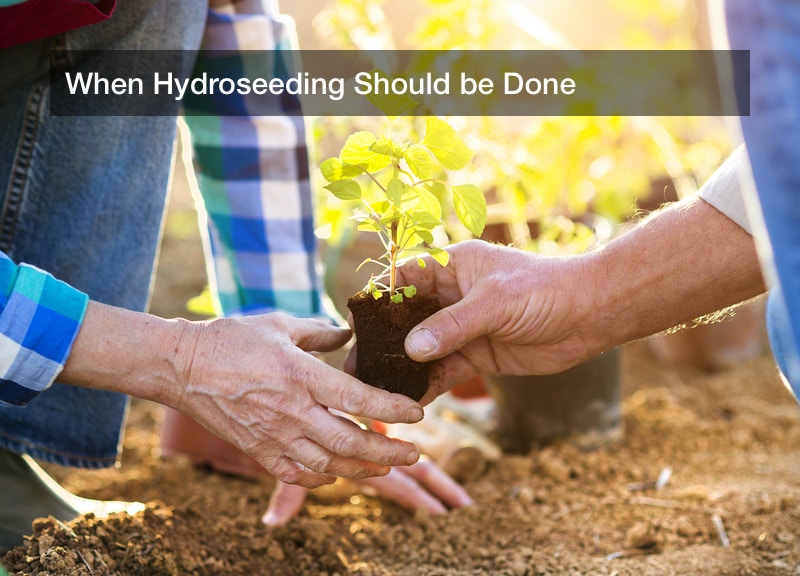
Spray on turf, known as hydroseeding, applies grass seed to the soil using a mixture of grass seed, water, fiber mulch, and other additives such as fertilizers. Often a bonding agent is also used to hold the mixture better together.
Many homeowners with large lawns choose to spray grass seed on their properties. Hydroseeding is not usually recommended for areas under 0.5 acres due to the cost of setting up the hydroseeding machine. The initial cost of hiring and setting up the tow behind hydroseeder is relatively expensive, so small lawns may not see any cost-benefit over other seeding methods. However, once the machine is set up, there is little extra investment needed for a larger area, making hydroseeding more cost-effective.
Every lawn requires individual attention to know which seeding method will work best. Before you decide whether to sod or hydroseed, it is good to perform a soil test. Soil tests will help you understand what nutrients are naturally in your soil. You can use this information to determine what type of fertilizer and grass seed are best for your lawn. Once you know more about your lawn and the soil base, you can decide if spay on turf, grass seeding, or sodding is right for your lawn.
In the past, one of the main drawbacks of spraying on grass seed for residential lawns was the cost to hire a professional. Hydroseeding was once only able to be completed by a professional service with a tow behind hydroseeder containing the grass seed slurry. The professional team then used a high-powered motor and hose to spray the mixture across your soil. Hiring a professional is still the most common practice for hydroseeding. However, several products have been introduced that allow for self hydroseeding. These may be the right choice for homeowners looking to fill in patchy spots on their lawns.
Plants are critical for the natural world and human use alike, and they have all sorts of applications for human civilization even today. Some plants are crops, grown to feed either people or livestock, or plants may be used for their natural fibers or wood. Trees have been used for countless generations for making housing, tools, boats, and more, and even bamboo can be shredded and pressed into wood-like planks for flooring. Other plants are used for decoration or landscaping, such as a row of blossom trees, flower beds, lily pads, and grass on a lawn or public area. Many commercial applications of crops and landscaping plants exist today, so proper technique for sowing and raising the seeds exist too. Plants do not appear from nowhere; they must be planted correctly, whether in a park, a nature preserve, or a farm’s fields. Using sod or dry seed broadcasting is common, but hydroseeding has demonstrated itself to be one of the more effective means of planting such plants. Hydrograss technologies and hydroseeding erosion control are popular today, and the advantages of hydroseeding are many. What are some of the advantages of hydroseeding, and where might it be done?
Planting Those Seeds

Plants must be planted to grow, and modern techniques for placing seeds for maximum growth have been developed. Gone are the days of oxen-drawn plows and using manure as fertilizer; today’s industries make use of tractors, trucks, and other machines to allow as many healthy plants to grow in as large an area as possible. And given the sheer size of the world’s human and livestock populations, maximizing plants and crops is clearly essential.
Hydroseeding is one such option. When this is done, a truck will deliver a tank of slurry to the site, and this slurry is made up of water, seeds, and mulch. This slurry is then sprayed across the intended area, and the advantages of hydroseeding may soon be apparent as opposed to dry broadcasting. The advantages of hydroseeding include the timing, since this process is a quick one compared to dry broadcasting and others. This may be essential if a very large area needs to have seeds planted, so the right vehicles and machines will be present. For very large areas, helicopters may fly by and perform hydroseeding from above, covering an area even larger than what a truck could handle.
The advantages of hydroseeding extend to the seed growth itself, since fiber mulch is involved in the slurry. This mulch can speed up the growing process, since it maintains the moisture around the seeds and thus boosts the overall germination rate. When this is done, significant grass growth may be seen within a week, and within three to four weeks, the grass will already be robust enough to need mowing and other maintenance work done on it. On top of all this, hydroseeding is a fine way to effect erosion control, as erosion may render some land unable to sustain plant growth and also look unattractive. When hydroseeding is done, a lot of grass is planted and rapidly grows, therefore controlling erosion. Erosion control has been known to happen on a larger scale with trees, and in Asia, the Chinese government is using trees to reduce desertification in that nation’s western lands. On a smaller scale, meanwhile, hydroseeding can keep a sloped grassy hill from suffering erosion.
Hydroseeding is often effective for landscaping, as any par or campus will look nicer when it has rich green grass growing on it. This can be time consuming and less efficient when done with older methods, so hydroseeding personnel may be called upon to help remodel a landscape with fresh grass. A city park, for example, may have some hydroseeding done if there are a lot of patches in the grass, or when the park is being built for the first time. Some parks are built entirely from scratch, and this includes their plant life. Grass, shrubs and bushes, trees, and more must be sown or transplanted there to complete the park. And in the case of very large parks or other areas, as described above, an entire helicopter may be employed to perform hydroseeding and get enough grass planted in the target area.

